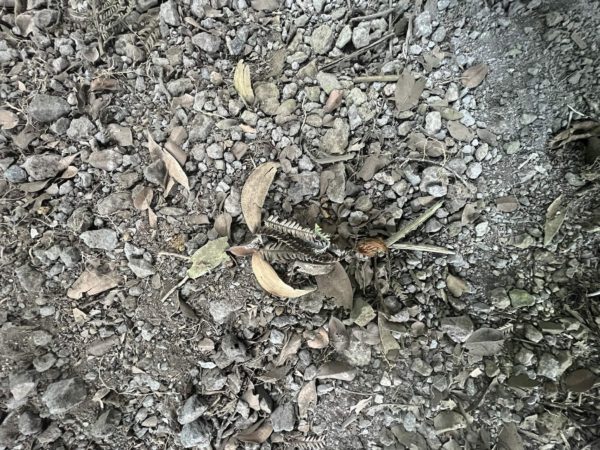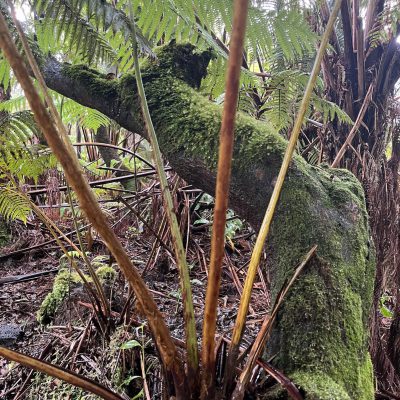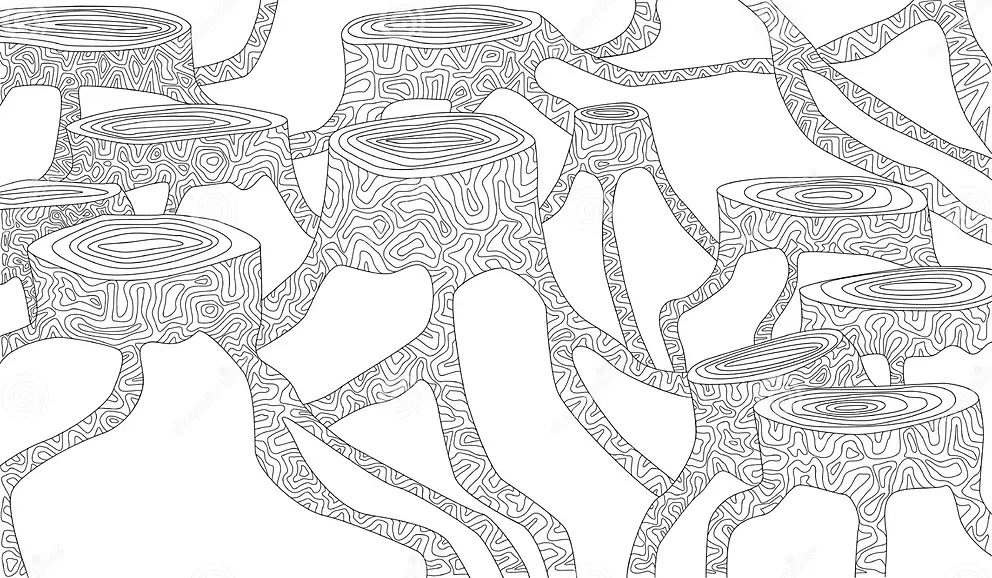Story Info
Story Info

Lizabeth Kashinsky
Hilo, HI
2022
Type of Wounded Place
Story & Experience
Due to some uncertainty about travel dates, I was not able to plan an Earth Exchange with my community this year and I ended up traveling on the day of. As I sat on a bench enjoying the cool shade of an outdoor garden at the Honolulu International Airport, I began to reflect on the human and nonhuman ancestors of the place and what great loss came before the concrete and introduced trees and other plants. I continued these reflections upon this as I arrived at the Hilo airport on the island of Hawaii, and despite the less urban feel, one could only imagine the community of plants, animals, and other nonhuman beings that once thrived where today there are daily travelers coming and going, and all the people that have passed through this airport with the vast array of human emotions that must have passed through this place. I continued my reflections the next couple days as I hiked the trails of the magnificent Hawaii Volcanoes National Park, a place of stunning beauty and awe. Yet I grieved for the loss of native species and the continual damage that myself and hundreds of visitors every year have on this place.
I ended my trip with what I felt was a culmination of what I was calling micro exchanges throughout my trip. While I had the privilege to stay at a friendʻs home that is surrounded by rainforest, the home is located in a housing development where all around you could see the scars and damage humans have caused in order to live in such an incredible place. As I walked around the yard, I found myself drawn to the side of the house by the water catchment that collects fresh rainwater that provides running water. I noticed a dead ohia tree, one of the most dominant and important trees of the Hawaiian rainforest, also a tree that is very culturally important to the Hawaiian people. The tree was presumably chopped down to make room for the house, and it spoke to me of how many other trees and ferns once lived where I was standing, providing habitat for native forest birds whose songs had been silent for years. I also noticed what appeared to be a recently dead tree fern.
Yet there was still beauty and a story of resilience told by the remaining trees and ferns that encircled the house. Scattered around the catchment was gravel, and it dawned on me that I had never really “seen” gravel until that moment. Crouching down, I began to ponder the story of this gravel, origins that will forever be unknown. I felt grief arise in my body as I imagined the violent blasts that probably shattered a once magnificent stone and how much fossil fuels were burned to import this gravel to Hawaii. My heart still hurts as I reflect back on my experience, that sense of helplessness and feeling trapped in a system where we are so reliant on fossil fuels and the mindset that keeps us in this system. As a final offering to gravel and place, I created the Rad Joy bird, and in doing so, I came back full circle to the feelings of gratitude and awe of this place and the resilience and power of nature. Perhaps it is because I have been paying more attention to the sacred in the mundane lately, but this Global Earth Exchange has also reminded me of how desecrated even the mundane around us. As difficult as that can feel, it also reminds me of the importance of honoring my own pain and grief, but how equally important it is to honor and connect with place and that placeʻs inhabitants, both human and nonhuman.
Due to some uncertainty about travel dates, I was not able to plan an Earth Exchange with my community this year and I ended up traveling on the day of. As I sat on a bench enjoying the cool shade of an outdoor garden at the Honolulu International Airport, I began to reflect on the human and nonhuman ancestors of the place and what great loss came before the concrete and introduced trees and other plants. I continued these reflections upon this as I arrived at the Hilo airport on the island of Hawaii, and despite the less urban feel, one could only imagine the community of plants, animals, and other nonhuman beings that once thrived where today there are daily travelers coming and going, and all the people that have passed through this airport with the vast array of human emotions that must have passed through this place. I continued my reflections the next couple days as I hiked the trails of the magnificent Hawaii Volcanoes National Park, a place of stunning beauty and awe. Yet I grieved for the loss of native species and the continual damage that myself and hundreds of visitors every year have on this place.
I ended my trip with what I felt was a culmination of what I was calling micro exchanges throughout my trip. While I had the privilege to stay at a friendʻs home that is surrounded by rainforest, the home is located in a housing development where all around you could see the scars and damage humans have caused in order to live in such an incredible place. As I walked around the yard, I found myself drawn to the side of the house by the water catchment that collects fresh rainwater that provides running water. I noticed a dead ohia tree, one of the most dominant and important trees of the Hawaiian rainforest, also a tree that is very culturally important to the Hawaiian people. The tree was presumably chopped down to make room for the house, and it spoke to me of how many other trees and ferns once lived where I was standing, providing habitat for native forest birds whose songs had been silent for years. I also noticed what appeared to be a recently dead tree fern.
Yet there was still beauty and a story of resilience told by the remaining trees and ferns that encircled the house. Scattered around the catchment was gravel, and it dawned on me that I had never really “seen” gravel until that moment. Crouching down, I began to ponder the story of this gravel, origins that will forever be unknown. I felt grief arise in my body as I imagined the violent blasts that probably shattered a once magnificent stone and how much fossil fuels were burned to import this gravel to Hawaii. My heart still hurts as I reflect back on my experience, that sense of helplessness and feeling trapped in a system where we are so reliant on fossil fuels and the mindset that keeps us in this system. As a final offering to gravel and place, I created the Rad Joy bird, and in doing so, I came back full circle to the feelings of gratitude and awe of this place and the resilience and power of nature. Perhaps it is because I have been paying more attention to the sacred in the mundane lately, but this Global Earth Exchange has also reminded me of how desecrated even the mundane around us. As difficult as that can feel, it also reminds me of the importance of honoring my own pain and grief, but how equally important it is to honor and connect with place and that placeʻs inhabitants, both human and nonhuman.
Hilo, HI
RECENT STORIES
Remembrance Day for Lost Species in Helsinki 2023
On November 30th, there was first a session organized by the Finnish social and health sector project about eco-anxiety and eco-emotions (www.ymparistoahdistus.fi). This “morning coffee roundtable”, a hybrid event, focused this time on ecological grief [...]
Ashdown Forest
Ashdown Forest is an area of natural beauty in West Sussex, England. It is also one of the very few remaining areas of extensive lowland heath left in Europe. This rare and threatened landscape is [...]





